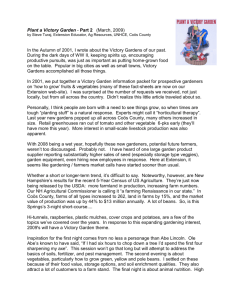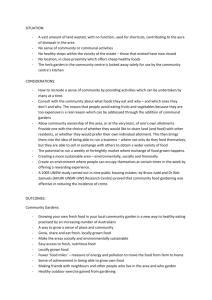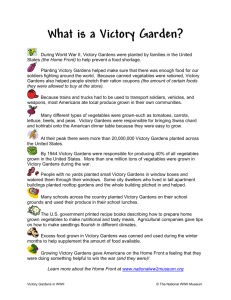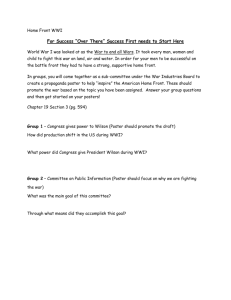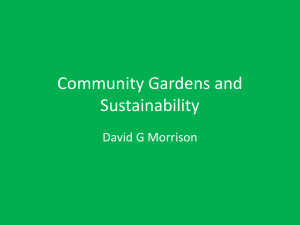Document 14314393
advertisement
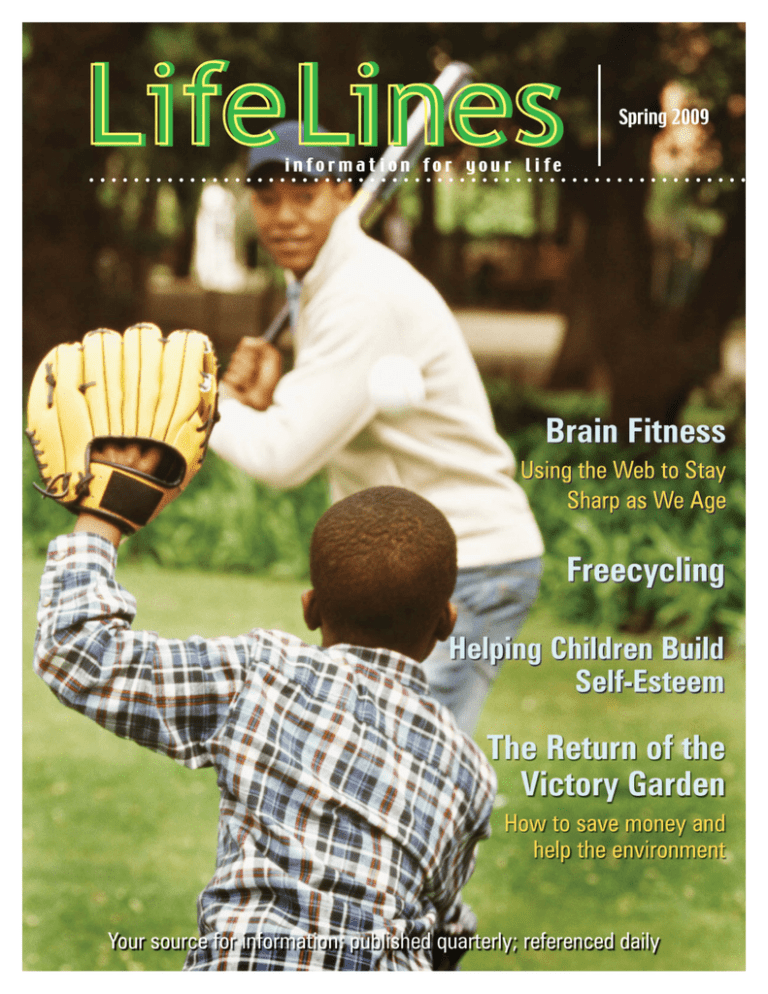
The bad news: “Cognitive decline is a nearly universal aspect of the aging process.” This is from Henry W. Mahncke and his friends at the University of California at San Francisco. They call it “agerelated cognitive decline” or ARCD. The good news? The brain is “plastic,” that is, it retains a lifelong capacity for physical and functional change. This is important, because medical and pharmacological advances are helping many to live past 80, the age when the incidence of all types of dementia rises sharply. Free resources on the World Wide Web can help maintain our brains’ plasticity in three ways: with advice and support for nutrition and fitness, puzzles and games to challenge our intellect, and online social interaction to fight loneliness. Stay Fit and Eat Right 460 surviving participants of the Scottish Mental Survey of 1932 were recently tested, at age 79, on the same general cognitive test that they took at age 11. The results were surprising. Overwhelmingly, the strongest correlation to the preservation of IQ after 68 years was physical fitness! It appears that a healthy brain is linked to a strong heart and circulatory system, which provide oxygen to neurons. Physical activity, even something as simple as taking a walk, keeps the blood flowing freely to the head. Along with maintaining physical fitness, we should eat a heart healthy diet that includes lots of fruits, vegetables, low-fat milk products, and little salt. The National Institutes of Health offers guidelines for nutrition and fitness. Visit their site, NIHSeniorHealth (http://nihseniorhealth.gov) and choose to “Find a Health Topic” under the letter “E”. There, you will find information on “Exercise for Older Adults” and “Eating Well as You Get Older.” Watch video examples of simple exercises and learn how to track your progress with charts. Recent research has shown that lonely elderly patients are more than twice as likely to develop Alzheimer’s disease! Humans are social animals, and we need interaction to help our brains work properly. Many of us already keep in touch with family and friends using email, which is really just like writing an old-fashioned letter, only faster. Recently, a new twist on computer communication has come to the fore. The technical name for it is “social networking.” Examples include MySpace and a site that has exploded in popularity: Facebook.com. Play Games to Stay Smart Wouldn’t it be great if just doing puzzles could help prevent age-related dementia? In 2002, scientists did a study to see if doing mental exercises could improve the cognitive skills of the elderly. The results were “cautiously optimistic.” There are lots of places to find games and brain teasers on the Web. Here is an assortment of free mind-challenging entertainments: • BrainBall http://brainball.playwithyourmind.com A free account on Facebook gives users a place to post pictures, thoughts, and to exchange news with other registered users. Given that Facebook reached 150 million members in January 2009 and is still growing exponentially, it is likely that people you know have already joined and are waiting to “friend” you, that is, to request permission to be part of your circle. Facebook’s flow of news and pictures among acquaintances provides an extraordinary sense of connection. This technology offers an easy and pleasant way to rekindle old friendships and keep in touch with family members. Wise Guys If we use these Web resources to connect with friends, play games, and keep fit, we have a good chance to keep cognitive decline at bay. Visit this site to get a daily dose of logic, spatial sense, and memory puzzles. Rank your score against other online players! • BrainBashers http://www.brainbashers.com Britain’s Kevin Stone offers this high quality, free selection of logic puzzles and brain teasers, sudoku, crossword puzzles, and even stereograms. • Games for the Brain http://www.gamesforthebrain.com Find free brain teasers that test memory and logic. Workplace Options, 2009. All rights reserved. Getting started with freecycling is easy. Visit www.freecycle.org Welcome to freecycling! Freecycling is a system of online networks where ordinary people can trade unused items for things they really need. By simply posting a notice about an unused article on a freecycle website, you can clean out your basement or garage, and keep landfills free of excess stuff. It is also a wonderful way to find items you might need, but can’t or don’t want to pay for. Getting started with freecycling is easy. A visit to www.freecycle.org will tell you that there are over 4600 freecycling groups with more than six million members. Enter your locale and you can find an online freecycling group in your neighborhood. Once you sign up, you will have access to postings that other members have added. Or you can post the things you would like to get rid of. Each freecycling network has a volunteer that moderates posts to make sure members follow the rules of etiquette: Freecycle Etiquette • No political messages and no spam. Two strikes and you are removed from the group. • Use phrases in the subject line that make it easier for your fellow group members. For example, if you have something to give write “Offer: Old Couch” and what area it can be found in. Or “Wanted: Usable baby furniture.” • Freecycling can be used to find new homes for pets as long as it is legal and the offerer is not asking for money. • Items must be free of charge. • Responses are sent only to the person offering the item, not to whole group. • Pick-up is arranged between members, and the person posting an item decides who receives it. When you sign up for freecyling, there are instructions on how to limit the amount of emails you receive announcing new items. You can receive an email every time someone posts an item, but this can lead to a huge volume of mail. It does offer the fastest way to find out if an item you may be looking for has been posted. You can also adjust your preferences so that you receive only one email per day which lists all of the items that have been posted. You can also opt out of getting any email at all, choosing only to go on and search for items from the posted list. Tips for Successful Freecyling Remember, you are joining a freecycling community and there are responsibilities you have as group members. Your first post should probably be something you want to give away instead of an item you want. • Items must be free, non-hazardous, and appropriate for any age group. • Make sure you add a photo and an honest description about the condition of the item. • Do not use personal information in posting. You may want to meet in a public place to deliver or receive items. • Follow-through with your commitments to the other members. Show up when you say you are going to. Freecycling is a fun and easy way to exchange items and help the environment at the same time. Who knows? Maybe you can exchange your trash for someone else’s treasure. What things do children need to develop healthy self-esteem? • Support from adults who care for them and believe in them. • Time to talk with adults who show interest in what the children are doing, thinking, and feeling. • Rules for behavior that are fairly applied the same way each time and that children can understand. • Appreciation that helps children feel worthy. • Ways to deal with tough times in life, like sharing, controlling anger, solving problems, and dealing with stress. • Positive role modeling from adults who show children that they like themselves. What can I do to help my child build healthy self-esteem? • When your child misbehaves, focus on the behavior, not the child. Let your children know that you love and care about them, no matter what. • Encourage them with words and hugs. • Be honest and sincere when praising children for good work by saying, “I like the way you helped me get everything ready for our picnic,” instead of just, “Great job!” • Let your child know you value him or her as a person by saying, “I love you just the way you are.” • Let children learn who they are, instead of wanting them to be who you think they should be. • Find ways to help children grow with new experiences. • Allow children to think and work creatively. • Let children help do things that they can do safely, such as helping you prepare a meal, folding laundry, and washing the car (even if you can do these things faster and better). • Listen to your children and show your support of their ideas and concerns. • Be a positive model for your kids by showing you have good self-esteem. • Don’t rescue children from every tough time. Be available if they need your help, but let them work through their own problems. This helps children build self-confidence. • Balance your need to protect children with their need to take risks and grow. • Show respect for children by letting them make some choices and supporting their decisions. • Offer unconditional love and the gift of your time to them. Are there some things that might harm my child’s developing self-esteem? • Dislike the child’s misbehavior, not the child. Let your child know you still love him or her, even though you don’t like the crayon drawings on the wall. • Don’t call children names or label them with negative words. • Don’t tease children, because they often take it seriously. • Give compliments without being critical. • Don’t talk about your child when he or she can hear you. • Don’t compare your child to other children; each child is special and should be valued just the way he or she is. • Don’t try to make children into who you think they should be. Help them learn to love who they are. • Don’t wait until your child learns something new or does something right before you show your love. Children need to hear and feel a parent’s love all the time. U.S. Department of Defense, Military Homefront. (n.d.). Questions and answers about helping children build self-esteem. Retrieved July 21, 2008, from http://www.militaryhomefront.dod.mil/ This movement also helped save fuel and other resources that had been necessary to transport food from farms to city dwellers. Rising food prices, economic instability, and a move to purchase locally grown products have led to a resurgence of Victory Gardens all across America. With vegetables grown in the backyard or in a neighborhood plot, families can save money and reduce the amount of fuels needed to get commercially grown fruits and vegetables to the local market. The history of the Victory Garden stems back to WWI, when citizens were urged to plant war gardens to help in effort to keep the troops fed. Since people were growing food for themselves, the U.S. Government could purchase food from commercial farmers to provide to the troops. Gardens sprung up everywhere. Those with their own land dug up lawns and flowers to plant vegetables. City dwellers received permission from local governments to dig up park lands and other municipally owned properties to cooperatively plant crops for harvest. WWII saw an even greater number of Victory Gardens. Food was being rationed and was simply not available. Families planted gardens to keep produce on the table. Twenty million Americans planted in whatever space they had available. The reasons surrounding a resurgence of these home gardens are numerous. Fruits and vegetables are plentiful, and not in short supply due to recent wars. But economic factors including the volatile fuel market have caused great fluctuations in the price of fresh produce. Produce that travels for hundreds of miles to reach consumers is not as fresh, and requires fuel for transport. Local farmers’ markets have sprouted up all over the country to provide locally grown items to consumers. The modern Victory Garden takes that trend one step further. Planting a Victory Garden can be a wonderful project that families can participate in together. Children can learn lessons about saving money, the environment, and nutrition when they take part in planting and harvesting their own food. All individuals can have a sense of achievement that comes with eating foods they have grown themselves. If you have no experience gardening, you should visit your local library or search on the internet to learn the basics of growing your own fruits and vegetables. You can find many resources on the web to help you get started: The Freedom Gardens of the World website can be found at http://www.freedomgardens.org and offers an opportunity to network with other Freedom Gardeners. Revive the Victory Garden’s website at http://www.revivevictorygarden.org is a great place to learn about the history of Victory Gardens and has good tips about starting your own. Visit the U.S. Department of Agriculture’s Cooperative State Research, Education and Extension Service’s website at http://www.csrees.usda.gov/Extension/ to find cooperative gardens in your area. Get started with your own Victory Garden today! Workplace Options, 2009. All rights reserved. Resource and Referral For help when you need it, count on your work-life service for free, confidential support. Resources and referrals are available for matters related to work, family, relationships, caregiving, health, or any kind of support for your well-being— to help you make room for what matters most! For assistance any time, call 800-969-6162, or log onto www.helpneteap.com.
